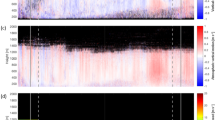Abstract
On occasion Greenbank et al. (1980) in their 1973 to 1976 study on spruce budworm moth dispersal in New Brunswick, Canada, detected intense line concentrations of airborne moths crossing special radar observing sites located about 100 km inland from both the Bay of Fundy and the Northumberland Straits. Line concentrations of insects reflect the presence of atmospheric convergence lines. Data from a surface mesonetwork and wind and temperature soundings up to 2 km collected in New Brunswick from 1976 to 1978 around the period of spruce budworm moth activity has revealed sea breeze fronts to be the meteorological origin for the line concentrations of moths. Analysis has shown sea breeze fronts penetrating 80 to 100 km inland in New Brunswick can be expected once or twice each year during the moth dispersal period. An equation for maximum inland penetration was developed which gave a correlation coefficient of 0.78 between predicted and observed inland penetrations with a standard error of 17.5 km. Predicted sea-breeze frontal penetrations of 100 km or more were considered likely to produce a line concentration of moths observable at the radar sited. Using this criteria the prediction scheme delineated four out of the five nights when line concentrations of moths were observed and only over-predicted on one occasion. Thus meteorological data can be used to predict the appearance of line concentrations of spruce budworm moths and so provide input into population redistribution studies and into the development of control strategies directed at the adult budworm.
Similar content being viewed by others
References
BELYEA, R. M., MILLER, C. A., BASKERVILLE, G. L., KETTELA, E. G. and VARTY, I. W. (1975): The spruce budworm. For. Chron., 51: 135–160.
BIGGS, W. G. and GRAVES, M. E. (1962): A lake breeze index. J. appl. Meteor., 1: 474–480.
BURDA, T. J., LEE, Y. and WILSON, J. W. (1979): Modeling sea breeze occurrences and potential fumigation effects in New England. In: Conference on Meteorology of Northern New England and the Maritimes. University of Southern Main, Gorham, 35–54.
DEFANT, F. (1951): Local winds. In: Compendium of Meteorology. T. F. Malone (ed.), Amer. Meteor. Soc., Boston, 655–672.
EVERSON, C. E. and BRISSETT, D. T. (1970): Climatic atlas of North America mean sea and lake surface temperatures. Technical Paper 70-3, 4th Weather Wing USAF, Ent. Air Force, Colorado, 39 pp.
FERGUSON, P. (1971): A sea breeze at Harrogate. Weather, 26: 125–127.
GREENBANK, D. O., SCHAEFER, G. W. and RAINEY, R. C. (1980): Spruce budworm (Lepidoptera: Tortricidae) moth flight and dispersal: New understanding from canopy observations, radar and aircraft. Mem. Ent. Soc. Canad. No. 110, 49 pp.
LYONS, W. A. (1972): The climatology and prediction of the Chicago lakebreeze. J. appl. Meteor., 11: 1259–1270.
RAINEY, R. C. (1973): Airborne pests and the atmospheric environment. Weather, 28: 224–239.
SCHAEFER, G. W. (1976): Radar observations of insect flight. In: Insect Flight. R. C. Rainey (ed.), Blackwell, Oxford, 157–197.
SIMPSON, J. E. (1964): Sea-breeze fronts in Hampshire. Weather 19: 208–220.
SIMPSON, J. E. (1978): The sea-breeze at Cambridge. Weather 33: 27–30.
SIMPSON, J. E., MANSFIELD, D. A. and MILFORD, J. R. (1977): Inland penetration of sea-breeze fronts. Quart. J. Roy. Meteor. Soc., 103: 47–76.
SMITH, M. F. (1974): A short note on a sea-breeze crossing East Anglia. Meteor. Mag., 103: 115–118.
THYER, N. (1962): Double theodolite pibal evaluation by computer, J. appl. Meteor., 1: 66–68.
THYER, N. (1970): Wind measurements near Alberta hailstorms, Part II. In: McGill University Stormy Weather Group Scientific Report MW-67. McGill University, Montreal, 1015.
WALLINGTON, C. E. (1959): The structure of the sea breeze front as revealed by gliding flights. Weather, 14: 263–270.
WILLIAMS, D. T. (1974): How you can forecast the sea breeze front along the Atlantic coast of southeastern United States. Presented at Third National Conference on Fire and Forest Meteorology. Lake Tahoe, Nevada. Amer. Soc. Meteor. and Soc. Amer. For. 35 pp.
Author information
Authors and Affiliations
Rights and permissions
About this article
Cite this article
Neumann, H.H., Mukammal, E.I. Incidence of mesoscale convergence lines as input to spruce budworm control strategies. Int J Biometeorol 25, 175–187 (1981). https://doi.org/10.1007/BF02184467
Issue Date:
DOI: https://doi.org/10.1007/BF02184467




